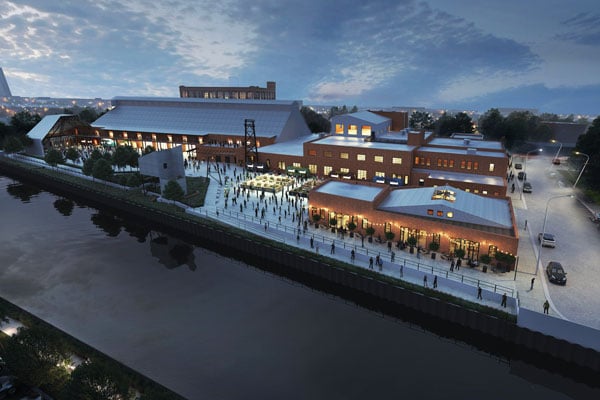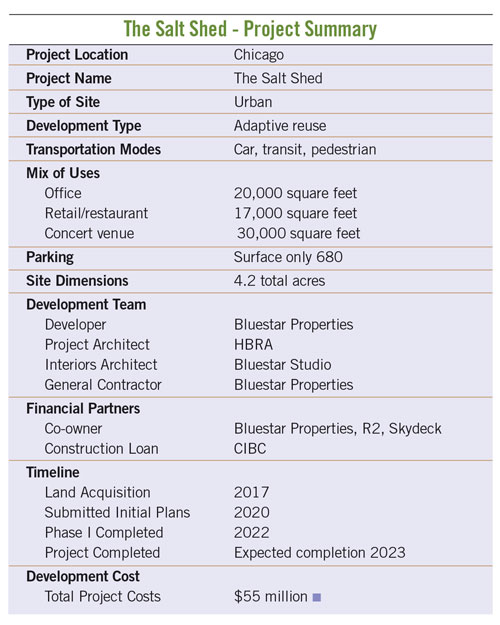From Salt Storage Facility to Concert Venue

An adaptive-reuse project in Chicago transforms an iconic industrial building into an entertainment destination.
The Morton Salt Company warehouse on Elston Avenue in Chicago once furnished tons of preservative salt for the city’s tanning industry. Today it is itself preserved — a city landmark in the process of rebirth as a concert venue combined with commercial and office space.
The complex, containing several buildings in a 4.2-acre site along the North Branch of the Chicago River, is being transformed to contain a 30,000-square-foot indoor concert venue in the former salt storage shed, 60,000 square feet of leasable office and commercial space in what had been a three-floor packaging building, additional space in a former garage, and an outdoor performance venue in the footprint of a recently demolished second salt shed.
The site is in the city’s North Branch Industrial Corridor, which has seen considerable development since partial rezoning in 2017 to encourage mixed-used development. The zoning of this site changed from M3-3, Heavy Industry District, to C3-3, Commercial, Manufacturing and Employment District.
The project is a collaboration between R2 Companies, Blue Star Properties and Skydeck. R2 has undertaken several conversion projects in the North Branch Industrial Corridor, including its headquarters and projects for CB2 and Passion House Coffee Roasters. R2 and Skydeck purchased the building in 2017 from Morton Salt for $15 million, with Blue Star joining as an equity owner more recently. Renovation work has cost roughly $40 million since.
Blue Star Properties is the interior designer and general contractor for the restaurant and live music group 16 On Center, a partnership between Chicago-based investors Craig Golden and Bruce Finkelman. 16 On Center owns and operates restaurants and concert venues in the Chicagoland area.
Blue Star had been seeking a larger stage for concerts and performances. The Salt Shed, with an indoor capacity of 3,800 and an outdoor capacity of 4,500, offered a leap up from the company’s current largest venue, which only holds around 900. The site also had a variety of other advantages; its largely commercial and industrial surroundings serve as a buffer against residential areas and provide relatively convenient evening parking. Another benefit is an unusually well-known site; most warehouse names aren’t exactly civic knowledge.
A Building That’s ‘More Like a Machine’
The Morton Salt complex was designed by Graham, Anderson, Probst and White, the Chicago architectural firm responsible for notable structures in the city such as Union Station, the Shedd Aquarium and the Wrigley Building. It was built between 1929 and 1930 as the company’s main Chicago storage and distribution center. The site along the river was chosen to provide easy barge, rail and road access. It launched amid the city’s golden age of agricultural processing uses, initially to provide salt for tanning operations nearby, and it continued to provide salt for many other purposes for 80 years. In later decades, it produced considerable amounts of rock salt for road de-icing. The Morton Salt Girl and the company’s famous “When it rains, it pours” logo have been replicated on the roof.
Matt Crawford, a coordinating planner at the Historic Preservation Division of the city’s Department of Planning and Development, said it’s been an iconic building for decades.
“Morton Salt is certainly one of the most visible of our industrial buildings,” he said. “It’s very visible from the Kennedy Expressway and a commuter rail line.”
The building was considered innovative when it was constructed, taking in massive quantities of salt by barge and distributing it by rail or truck. The exterior was almost superfluous, as Crawford noted.
“The building that resulted really functioned more like a machine,” he said.
Salt was stored in the shed and then moved to the packaging building by multiple conveyor systems. One ran to the top floor to harness gravity — the salt was packed as it descended downward. Multiple vast piles of salt towered dozens of feet into the air, which required other invisible solutions, according to the city’s landmark designation report, published in April 2021.
“Each section of the shed was completed as a large, reinforced concrete bulkhead, with steel tie rods encased in eight inches of concrete beneath the interior maple floor,” the report notes. “The tie rods helped to keep the side walls from otherwise pushing apart.”
Getting to Work
Golden said he found the initial condition of the site both challenging and inspiring.
“It was in the original abandoned state,” he said. “It was full of machinery and steel and lifts and things they left there. We were pulling stuff out of there for a year, as well as mounds and mounds of salt — it was packed with salt.”

The Salt Shed will host live music and other events. The developers were able to negotiate a narrowly crafted noise ordinance with the city of Chicago that allows them to host concerts at night. Blue Star
Rusted-out equipment and enough salt to provide decades of margaritas aren’t exactly workable theater decor, but the development team was intent on keeping as much of the site as was viable. According to Golden, the aim was “showing the life it had in the past, where you can see the layers of what happened in the ‘20s to the ‘50s to the ‘70s, and this is what we did — while putting in all-new mechanicals so that it operates as a functionally new building.”
The developers sought landmark status from the city for the complex, which was granted in 2021. They intended to make as much use of the site as possible. The former East storage shed, condemned by the city, was largely demolished in 2020, but the rest of the buildings are being renovated.
Some elements such as the roof couldn’t be retained, though.
“The roof system looked like corrugated metal,” Crawford said. “It was actually a cement and asbestos product called Transite. You can’t really buy an asbestos roof now, and if you could, you wouldn’t want to put it over an entertainment venue.”
Crawford said it was replaced by a manufactured roof panel system consisting of an insulated core sandwiched between inner and outer faces composed of sheet metal.
“The system is relatively lightweight and does not require reinforcing the existing steel trusses that are a character-defining feature of the shed’s interior,” he said.
While the open-span Salt Shed is ideal for concert use, it still needed plenty of work. The developers inserted elevators and other new mechanicals inside the site, as well as seating boxes and concert and stage infrastructure.
“Trying to keep the shed intact, we developed a plan to utilize the interior as best we could,” Golden said. “We had to make compromises a little bit on maximizing seating to create a space that really was more like being in the old salt shed.”
Salt works wonders at preserving food, but not metals. The steel truss holding up the shed had been substantially corroded by the material it was designed to shield. While much of that was replaced, Golden was intent on retaining whatever he could.
“We really took a painstakingly architectural approach to the shed itself, and we either restored or structurally enhanced the shed and its lattice steel structure,” he said.
Jeffrey Policky, an architect associate at HBRA, said the main difficulty his firm faced on the project was working around the building’s historic steel trusses.
“Keeping as much of the existing steel, concrete and brick allows the Salt Shed to be a unique space to experience music, and it also speaks to the former industrial use of the surrounding neighborhood,” he said. “While it’s the most interesting, the structure of the shed also became the most difficult challenge. As the grandstand rises in height to accommodate views of the stage, it engages the existing trusses and roof plane. Care was needed to avoid blocked sightlines and to allow headroom clearance underneath the steeply sloping roof.”
HBRA contracted Forefront Structural Engineers to analyze each piece of the existing truss structure.
“Our addition of the grandstand structure has allowed for less supporting steel being required at the north-end trusses,” Policky said.
The plan involves adding a partial second-level grandstand with a capacity of 400 and boxes and a VIP area with capacity for an additional 120 concertgoers. This posed some practical difficulties. The existing building envelope didn’t provide adequate space to access boxes on the building’s east side, so a covered hallway and balcony is being built along that side of the structure; the balcony will also offer river views. Another platform is being added to house mechanical elements.
Windows and doors were replaced, and new window openings were created throughout the project.
The venue features some innovative interior elements, namely DuctSox, a fabric ductwork system. The trouble with typical metal ductwork in an open space — especially a concert space — is how it reflects sound. DuctSox provided an acoustically deft and space-saving solution.
“It’s a fabric that’s kind of held open with a little bit of metal wiring and basically blows the air through a fabric duct instead of a metal duct,” Golden said.
These efforts are aimed at creating a suitable shell, which doesn’t require painstaking tweaks in early stages.
“This is not an opera house; it is mainly a rock & roll venue,” he said.
Additional work will be completed by OSA for sound design, Upstaging for lighting design and L Acoustics for PA system design.
Work Along the Waterfront
Outside, Golden saw another opportunity at the site of the demolished salt shed, which fronts the river.
“When we took it down, we stood there one day and we thought ‘wow, this would be a great outdoor venue,’ ” he said.
A portion of the old salt shed remains and is being used as a point of interest, Golden explained.
“We also left the end of the salt shed that we took down,” he said. “It was just a cool old frame. We left the last 25 feet as a remnant.”
The outdoor portions of the site required several alterations. The development team replaced the riverwall along the water’s edge, poured a concrete deck for the concert surface and is installing an assortment of landscaping elements.
According to Golden, the riverwall is about nine feet above the current water level. He is confident this will protect against most water risks.
“If it gets that high, it’s going to be a problem for a lot of people,” he said.
New sewerage and drainage have also been built. The development team is adding landscaping designed to absorb water. Lighting is also being added to a riverwalk.
“Hopefully, it creates a nice environment for meandering along the river before or during a show,” Golden said.
There were practical issues of access to address, namely parking.
“We’ve rented a lot adjacent to us for about 500 parking spaces,” Golden said. “We have about 250 spaces under our control.”
Golden explained that despite public perception, parking is not much of a problem at Blue Star’s other venues. Rideshare services and public transportation seem to be favored by most concertgoers in Chicago.
“As concert promoters, we haven’t found parking to be that challenging,” he said. “We have a valet for many shows. We rarely park more than 30 cars.”
The nature of the surrounding blocks — largely industrial and commercial — has also meant there’s not a great deal of competition for evening parking in existing street spaces. Golden says they’re hoping that upcoming developments will improve that balance as new projects come online nearby.
The venue is also about six blocks from the Division Street elevated rail station on the Chicago Transit Authority’s Blue Line. The developers are considering creating a shuttle between the stop and the venue.
Working With Local Officials
The most difficult issue in terms of a civic green light for the project was noise. The nearest residences are several blocks away across the Kennedy Expressway, but noise is always a permitting concern. Golden said the Morton Salt facility’s case was unprecedented in a regulatory sense. Concerts in public parks were already common in Chicago, but this was a new circumstance in a private space.
“The outdoor music has been the most challenging part just to get the final approval,” Golden said. “We realized there was not a current ordinance in the city of Chicago for a non-publicly owned outdoor venue.”
Golden said negotiations with the city were successful.
“The city did a very nice job of working with us to craft a kind of narrow ordinance that mainly stipulated times when music must end,” he said. “This will allow us to have a limited amount of outdoor music.”
Chicago’s Department of Planning and Development also worked with the development team to provide financial incentives for the project.
“The city gave us a Class L designation, basically freezing the taxes at the current level for 12 years,” said Golden. “That gave us the incentive to put all the time and effort into saving the old salt structure, which we wanted to do.”
Chicago’s Class L Property Tax Incentive requires the owner to invest at least half of the value of a property into its rehabilitation. Usually, land conversions in the city’s industrial corridor also require a conversion fee. These were waived in 2020 for landmarked buildings that meet some additional zoning requirements, as the Morton Salt complex did.
Outdoor concerts began on August 1, with this summer’s lineup including Fleet Foxes, Courtney Barnett, Jorja Smith and Death Cab for Cutie.
An Ongoing Project
The facility is now open, though there’s more work to be done. Blue Star recently began leasing the first floor of the Packing House.

“We have current plans or leases for a brewery, a catering kitchen, commercial loft office space, and a third-floor indoor/outdoor event space with available maker/retail space on the first floor,” Golden said.
Morton Salt is slated to occupy a portion for research and development space. Otherwise, leasing remains a work in progress.
“A renovation is different from new construction; until companies can see what they’re getting, they don’t quite get it,” Golden said. “We’re happy with the progress that we’re making.”
Blue Star also hopes to attract a distillery to an original garage structure that was once used for repairing equipment and vehicles. Additional nods to the site’s history are also in the works.
“We’re actually hoping to put in a bridge between the Salt Shed and the Packing House that alludes to the bridge that used to connect the buildings with the conveyor belt,” Golden said.
The developers are aiming to begin indoor concerts early in the first quarter of 2023.
The undertaking is different, and more difficult, than simply constructing a new concert hall, but that’s not what the developers wanted.
“You can just rebuild and it can be attractive, but if you want to retain the authenticity of the property, it does take a lot more work,” Golden said. “[This property has now been rehabilitated to highlight] its past glory. It’s a really cool thing to see.”
Anthony Paletta is a freelance writer based in New York.
|
New Course: ‘Fundamentals of Adaptive Reuse’ Adaptive reuse projects allow developers to utilize their creativity and vision to transform aging structures for new, fresh uses. NAIOP’s Center for Education recently launched “Fundamentals of Adaptive Reuse,” an interactive, on-demand course that provides learners with a detailed look at this dynamic product type. Gain an understanding of the adaptive-reuse approach, methods for evaluating whether an adaptive-reuse project is worth pursuing, crucial steps of the due-diligence process, the key players that make up an effective project team, and the funding available for financing these types of projects. The course explores each step in the adaptive-reuse process, outlines common challenges and solutions, and evaluates diverse adaptive reuse projects through real-world case studies. For more information, visit learn.naiop.org |




